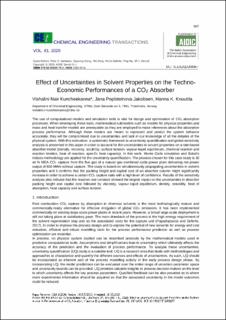| dc.contributor.author | Kuncheekanna, Vishalini Nair | |
| dc.contributor.author | Jakobsen, Jana Poplsteinova | |
| dc.contributor.author | Knuutila, Hanna K | |
| dc.date.accessioned | 2022-05-09T12:27:15Z | |
| dc.date.available | 2022-05-09T12:27:15Z | |
| dc.date.created | 2020-08-28T14:48:29Z | |
| dc.date.issued | 2020 | |
| dc.identifier.citation | Chemical Engineering Transactions. 2020, 81 997-1002. | en_US |
| dc.identifier.issn | 1974-9791 | |
| dc.identifier.uri | https://hdl.handle.net/11250/2994806 | |
| dc.description.abstract | The use of computational models and simulation tools is vital for design and optimisation of CO2 absorption processes. When developing these tools, mathematical submodels such as models for physical properties and mass and heat transfer models are prerequisite as they are employed to make inferences about the absorption process performance. Although these models are meant to represent and predict the system behavior accurately, they will be compromised due to uncertainties and lack in our knowledge of all the detailes of the physical system. With this motivation, a systematic framework to uncertainty quantification and global sensitivity analysis is presented in this paper in order to account for the uncertainties in solvent properties on a rate-based absorber model (density, viscosity, solubility, surface tension, vapour-liquid equilibrium, chemical reaction and reaction kinetics, heat of reaction, specific heat capacity). In this work, Monte Carlo simulation and Sobol’s indices methodology are applied for the uncertainty quantification. The process chosen for this case study is 30 wt % MEA CO2 capture from the flue gas of a natural gas combined cycle power plant delivering net power output of 830 MWe without capture. The study is based on simultaneously propagating uncertainties in solvent properties and it confirms that the packing height and capital cost of an absorber column might significantly increase in order to achieve a certain CO2 capture ratio with a high level of confidence. Results of the sensitivity analysis also indicate that the reaction rate constant showed the largest impact on the uncertainties in absorber packing height and capital cost followed by viscosity, vapour-liquid equilibrium, density, solubility, heat of absorption, heat capacity and surface tension. | en_US |
| dc.language.iso | eng | en_US |
| dc.publisher | The Italian Association of Chemical Engineering (AIDIC) | en_US |
| dc.rights | Navngivelse 4.0 Internasjonal | * |
| dc.rights.uri | http://creativecommons.org/licenses/by/4.0/deed.no | * |
| dc.title | Effect of Uncertainties in Solvent Properties on the Techno-economic Performances of a CO2 Absorber | en_US |
| dc.title.alternative | Effect of Uncertainties in Solvent Properties on the Techno-economic Performances of a CO2 Absorber | en_US |
| dc.type | Peer reviewed | en_US |
| dc.type | Journal article | en_US |
| dc.description.version | publishedVersion | en_US |
| dc.source.pagenumber | 997-1002 | en_US |
| dc.source.volume | 81 | en_US |
| dc.source.journal | Chemical Engineering Transactions | en_US |
| dc.identifier.doi | 10.3303/CET2081167 | |
| dc.identifier.cristin | 1825815 | |
| cristin.ispublished | true | |
| cristin.fulltext | original | |
| cristin.qualitycode | 1 | |

